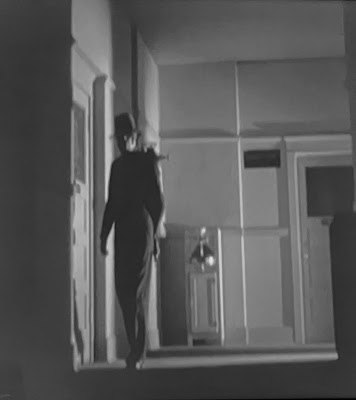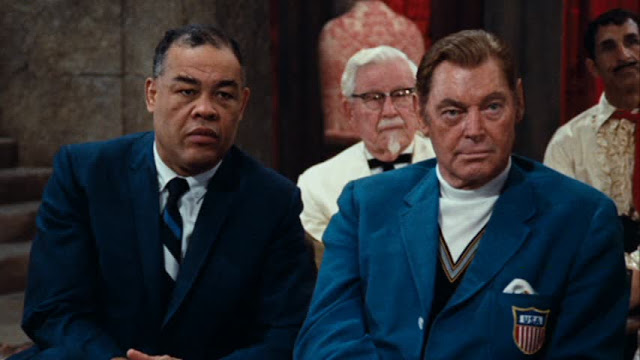I recently picked up and flipped through my copy of William K. Everson's classic A Pictorial History of the Western Film, as one does when escaping the heat of an Alabama summer day. What did I find but a couple of stills and some discussion of Johnny Mack Brown's role as William Bonney in the 1930 film Billy the Kid. Let's investigate.
Thursday, September 21, 2023
Johnny Mack Brown as Billy the Kid
Friday, September 15, 2023
Gail Patrick in "The Preview Murder Mystery"
One of the topics I bring out from time to time on this blog is film actresses from the state whose careers began before 1960. I've covered some others after that date, too, but today's post fits that group.
One of those pre-1960 actresses is Birmingham native Gail Patrick. A career overview I posted in 2015 is here. In 2019 I wrote about her role as a private detective [really!] in Murder at the Vanities, a truly bonkers 1934 pre-code film. In 2020 I posted about her post-acting career as Executive Producer on the classic Perry Mason TV series and her appearance in the final episode. In 2021 I wrote about her role as the femme fatale in The Maltese Falcon--a radio version, but still....
Now we come to her role in The Preview Murder Mystery from 1936. I watched this one recently on TCM and really enjoyed it. There's a rather interesting framing device--it's a movie about the making of a movie and features quick action, witty dialog and some murders. Director Robert Florey would helm over 50 movies and numerous episodes of TV shows in his long career. By the time he made this one, he had already directed such classics as the Marx Brothers first feature, The Cocoanuts [1929] and Murders in the Rue Morgue [1932].
The film being filmed is "Song of the Toreador", and we get to see some extensive scenes in its preview screening. We also see even longer scenes involving the filming process, so that the cast and crew of "Toreador" are much of the cast and crew of Preview. Very meta. "Song" is a remake of a silent film starring the late husband of Patrick's character, Claire Woodward Smith.
A lot of this film's snap, crackle and pop is courtesy of the performances by and dialog written for Reginald Denny and Frances Drake as they play the studio publicity head and his secretary. A running gag is Denny's constant proposals of marriage, and refusals by Drake, whose character is an astrology nut and keeps telling him the stars are not aligned properly.
Catch this movie if you have a chance. It's only an hour long and is available on YouTube.
Some more comments are below.
Friday, August 4, 2023
Joe Louis in "The Phynx"
I can guess what you're thinking--what's a phynx? Let's investigate.
"The Phynx" is a film released briefly in May 1970 by Warner Brothers Studios. Warner finally released it on DVD in 2012, and I watched it recently on Turner Classic Movies. The movie is certainly not a classic, but it has some amusing moments.
A plot summary is hilarious enough. Communists in Albania have kidnapped a number of celebrities from American entertainment and sports worlds. I don't even remember why. In order to free the hostages, U.S. intelligence puts together a rock band from scratch and turns them into world superstars. The group's name? The Phynx, of course. Once famous, the group can appear in concert in Albania and rescue the celebrities.
But wait--there's a hitch. There's a secret map that will lead the musicians to the castle where the hostages are being kept. The map is drawn in three parts on the tummies of three beautiful young women residing in different European cities. In order to find the pieces, Phynx members must "examine" hundreds of women. After that exhausting ordeal, they put the map together and head for Albania.
Are you with me so far?
Naturally, all the kidnapped celebrities are found and released. A major feature of this portion of the film is a sequence in which they are all introduced to us, the viewers, before leaving Albania. The list includes Johnny Weissmuller and Maureen O'Sullivan (the most famous movie Tarzan and Jane), Leo Gorcey and Huntz Hall (the Bowery Boys), Ed Sullivan, James Brown, Colonel Sanders, Guy Lombardo, Andy Devine, Ruby Keeler, Edgar Bergen, Butterfly McQueen, Jay Silverheels (Tonto), Rudy Vallee, Xavier Cugat, Trini Lopez, Dick Clark, Richard Pryor, Harold "Oddjob" Sakata, George Jessel, and Rhona Barrett.
Alabama native and former heavyweight boxing champ Joe Louis was also included. As the stars leave the castle in horse-drawn carriages, no less, we see duos or trios of them cracking jokes. Johnny Weissmuller says "Me Tarzan, you Jane" to O'Sullivan, a phrase never uttered during any of their many movies together. Louis and Marilyn Maxwell are sitting together and Louis actually makes an income tax joke, referencing his well-known woes with the IRS over back taxes he owed.
This film is crazy, baby, really far out. But I had fun watching it. The parade of mostly-aging, many-by-1970 forgotten stars is a shout-out to people who had entertained millions across the decades. I remember often watching Leo Gorcey and Huntz Hall as the Bowery Boys when I was a kid, on Saturday mornings, I guess. They weren't as funny as the Three Stooges, but were pretty amusing. I also appreciated the appearance of John Hart as the Lone Ranger. I much preferred him over Clayton Moore, whom he replaced in the 1952-53 season during a contract dispute.
The list goes on. Dorothy Lamour! Martha Raye! Joan Blondell! Ed Sullivan! Ruby Keeler! Rudy Vallee! Clint Walker in a hilarious turn as a master sergeant! Oh, and there's Richard Pryer! Butterfly McQueen! Trini Lopez! Sadly, I'm old enough to know who all these people are/were. Check out the film's IMDB entry for a full cast list.
I should note one other appearance. Actress Sally Struthers made her first film appearance, although uncredited, as the World's Number One Fan of The Phynx.
Louis and Weissmuller looking serious earlier in the film. Who's that mysterious gentleman behind them??
Friday, November 11, 2022
"Nice girl. Alabama born."
OK, here's a post where I bring up a minor Alabama connection. Why? Because they're fun! I've done this sort of thing before, such as the piece on the 1960 film Ocean's 11 in which two such connections pop up.
I watch most of the Noir Alley films hosted by Eddie Muller on TCM, and this reference appeared recently in The Argyle Secrets released in 1948. The film is about the search for an album containing information on the Nazi sympathizer backgrounds of some prominent Americans. There are more crazy plot twists than contained even in such classics as The Maltese Falcon and The Big Sleep. Muller noted that writer-director Cy Enfield may have intended his film to be both an example and a send-up of the genre.
So what's the Alabama connection, you ask?
That involves Evelyn Court, the character played by Barbara Billingsley. Early in the film our ostensible hero, journalist Harry Mitchell [William Gargan] has an encounter with Court and knocks her out with a right hook so he can search the office where she works. Later, one of the villains, Panama Archie, tells Mitchell he has talked with Court. "Nice girl. Alabama born," are his immortal words.
And there you are!
Enfield wrote the original version of the story for the Suspense radio series which first aired it as "The Argyle Album" on September 4, 1947. You can watch this film on YouTube. The original radio version is also on YouTube.
Several actors in The Argyle Secrets later created memorable characters on television. Billingsley played the mother June Cleaver on Leave It To Beaver from 1957 until 1963. The femme fatale was played by Marjorie Lord, who starred as the wife and mother on The Danny Thomas Show [1956-1964]. One of the bad guys was played by John Banner, [1910-1973] who had more than 40 film and over 70 TV appearances but is best known as Sergeant Schultz in the World War II TV comedy series Hogan's Heroes.
Jack Reitzen as Panama Archie and William Gargan in the scene where Panama mentions a nice Alabama girl.
Thursday, October 27, 2022
Alabama on the Hollywood Walk of Fame (1)
Mary Anderson [film]
Clarence Brown [film]






















































